|
|
|
|
|
|
Mirror
Frame with 'Plants Box' in the Stile of Neo Baroque,
19th Century
|
| Introduction |
|
|
Dimensions:
|
|
Mirror
frame - 300 cm in height, 145 cm in width, 9cm on the
thickest part.
'Plants box' - 38 cm in height, 95 cm in width, 38 in
length. |
|
| Final
facing: |
|
|
Parcel water
silvered, parcel water gilded, parcel imitation of gilding |
|
| Type
of treatment: |
|
| Restoration |
|
| Storage
and display: |
|
|
Private collection,
for everyday use |
|
|
|
|
|
|
|
|
Condition
The Mirror
frame arrived in studio separated from crown elements.
The body of mirror frame and 'plants box' were cowed
with thick layer of probably bronze powder emulsion,
which oxidized. Crown elements were covered with layer
of dark yellow material, probably shellac, blended with
dust so the surface head rough look. All surfaces were
embedded with surface dirt.
In constructional sense, Body of mirror frame was solid,
as well as the 'plants box' although, on the down panel
of the body of mirror frame, the long crack was visible.
The crack was the after effect of change of properties
of thin (13 mm) wooden board due to aging and influence
of environment. The crown elements were broken along
the joints. Cause was yielding of organic adhesive,
probably fish aye glue, under the influence of environment.
Traces of this adhesive were visible on the joining
parts. Some parts of crown ornaments missed. Elements
for mounting of the crown missed too.
Along the frame area which mounting the very mirror,
parts of ornament missed. Also, many small cracks were
visible.
Small parts of ornaments missed on the 'plants box'
too (fig.1., fig.2., fig.3. & fig.4.).
Technical
Analysis
Prior to
restoration work the following analysis were performed:
Analysis
of Materials and Techniques Involved
The body
of mirror frame, crown, and the 'plants box' was made
of Pinewood (Pinus nigra). Ornaments wear made by woodcarving
except the floral ornaments on the forehead and on a
sides of 'plants box', along the frame area which mounting
the very mirror, under the candela holders plate attached
on the mirror frame and above the down panel of mirror
frame. Those ornaments were made of traditional stucco.
Some surfaces were covered with traditional gesso approximately
2mm thick, (calcium carbonate powder and organic adhesive
probable fish-eye glue), then with very thin layer of
dark ocher bole. Those surfaces were gilded and silvered
by water gilding technique. Other were decorated with
imitation of gilding probable using schlag metal foil
and some oil size technique.
Identification of Cowers on the All Parts of the Object
As it was
presumed, the layer of cower on the body of mirror frame
and the 'plants box' was the bronze powder mixed with
inorganic adhesive.
|
|
|
|
|
|
|
|
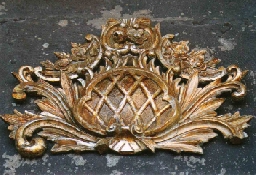 |
|
|
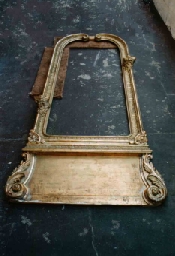 |
|
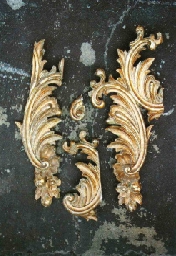 |
|
|
|
|
|
fig.3.
click to zoom |
|
|
|
|
|
|
|
|
|
 |
|
|
fig.1.
click on to zoom |
|
fig.2.
click on to zoom |
|
|
|
|
|
|
|
|
|
|
|
|
|
fig.4.
click on to zoom |
|
|
|
| Choice
of Treatment
Treatment
on this object was performed in two phases:
Phase
I: Choice of Cleaning Treatment
Selection
of Solvents for Cower on the All Parts of Object
Test for
dissolution of cower was performed by two solvents on
the samples taken from the body of mirror frame and
'plants box'. Solvent Nr.1 was prefabricated methanol
free, acid paint remover (1). Solvent Nr.2 was the admixture
of methylen chloride, methanol, cellulose powder and
paraffin oil. Evaporation time, do to presence of cellulose
and paraffin was appreciably reduced, concentrating
the reaction on cower. Solvent Nr.1 endangered the original
surface made of traditional gesso with organic adhesive.
The test with solvent Nr.2, after 20 minutes of exposure,
resulted in complete dissolution of cower substance.
Dissolved substance was rinsed with nitro thinner (2).
After the process gesso and final facing on it stayed
undamaged. Same procedure was tested for removing cower
on the crown. Test resulted with same effect.
Cleaning
Process
Adopted
solvent Nr.2 was gradually applied on all surfaces.
After 20 minutes dissolved cower substance was rinsed
with nitro thinner (2). On some areas process was repeated
due to very thick layer of cower.
Organic adhesive left on the faces of broken joints
was melted with beam of water steam and removed mechanically.
During cleaning process front legs of 'plant box' delaminated,
revealing the long nails.
The original gesso surface open up in numerous small
cracks, especially visible on the silvered areas. Parts
of gesso delaminated from wooden surface.
Cracks in Traditional Stucco areas, opened up after
rinsing, were filed with plaster. Also parts of stucco
ornaments were made of plaster probably before they
were covered with bronze powder emulsion in try of restoration
time age. Plaster was removed mechanically during the
cleaning treatment. During the treatment imitation of
gilding was removed (fig.5.).
Object was left for few ours to dray and then test with
drop of water was performed to determine ability of
porous. Result of test was good so it was decided not
to repeat cleaning process.
|
|
|
|
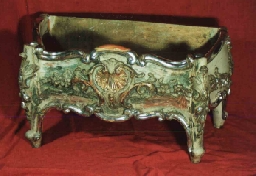 |
|
|
fig.5.
click on to zoom |
|
|
|
|
Phase
II: Choice of Restoration Treatments
Selection
of the Materials and Procedures for Crack Recovering
For recovery
of cracks in wooden body test was made with admixture
of powdered gypsum (CaSo4), kaolin and PVAC resin. Prior
to application of admixture crack was moistened with
15% ethyl alcohol to assure good contact of admixture
and wood. Solidification time was about 15 minutes.
Sample was left to dray for 12 hours. Test resulted
with solid, consolidation backfill. For recovery of
larger and deeper cracks in Traditional Stucco, which
were presenting risk for the firmness of structure,
same procedure were tested, resulting with same solid,
consolidation backfill. Filer for Smaller cracks, which
were not presenting a risk for the firmness of structure
and would not be later cowered with gesso, was founded
within prefabricated CLOU filling waxes (3).
Selection
of the Materials and Procedures for Consolidation and
Recovering of Original Gesso
Due to good
experience with admixture tested on cracks, it was tested
for filling of areas where the parts of original gesso
delaminated. Area was prepared with 15% ethyl alcohol
as the crack in previous test. Admixture was pushed
into and flattened with moistened spatula. The Result
was satisfactory.
In order to consolidate the numerous small cracks in
original gesso, make better contact within original
gesso and new fill and make solid ground for new gesso
the 'contact ground' was tested. Request was to obtain
surface solid enough to resist pressure during the polishing
of gold and silver and porous to except new gesso. The
ground was composed of calcium carbonate, in form of
fine powder (Bologna chock), zinc oxide powder and PVAC
resin. By the and of mixing 90% Izo propil alcohol was
added to improve leaving of captured air. To make it
applicable with brush admixture was diluted with distilled
water. Surface was coated 3 times with time delay of
15 minutes to provide solidification time for each layer.
Sample was left to dray for 12 hours. The result was
solid but porous surface, enough resistible on pressure
preventing the original gesso from delaminating.
Restoration
Process
Nails from
the `plants box` legs were removed. Joints were supported
by dowels and affixed with aliphatic resin glue (4).
Dowels and aliphatic resin glue were used too to support
the down panel of the body of mirror frame. Six 8x100
mm dowels were placed, with distance of 10 cm, through
the down rail of the frame of the down panel in a board
of the down panel. Missing parts of woodcarver ornaments
were made of similar wood - Pinewood (Pinus nigra) (fig.6.).
Silicon moulds were made for missing ornaments in areas
of traditional stucco. Some ornaments with unique shape
were made by sculpturing. In both cases prefabricated
material - Model plaster (5) with addition of PVAC resin
was used. Ornaments were left to dray for 12 ours (fig.7.).
Tested admixture was applied on cracks and flattened
by moistened spatula. Priors to application cracks were
moistened with 15% solution of Etil alcohol. Smaller
cracks were field with CLOU wax (3) (fig.7.).
Delaminated peaces of gesso were removed mechanically.
Previously tested Procedure was applied now. After 12
ours of drying areas of intervention were shaped by
the help of turbine.
|
|
|
|
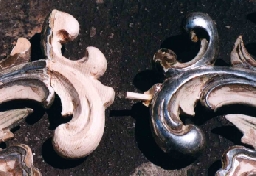 |
|
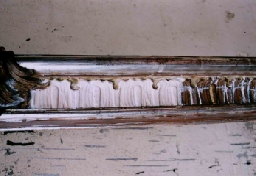 |
|
|
fig.6.
click on to zoom |
|
fig.7.
click on to zoom |
|
|
|
|
|
|
|
|
Prior
to application of the 'contact ground' whole surface of
object was cleaned whit 96% etil alcohol. The 'contact
ground' was applied in three layers as it was tested and
then it was left to dray for 2 hours (fig.8.). New traditional
gesso consists of technical whiting (CaCo3), zinc whiting
(Zn2O) and rabbit skin glue was applied shortly afterwards
in four layers. Every layer was left to solidificate for
15 minutes. The ground and the new gesso was applied only
on surfaces planed for water gilding and silvering and
on surfaces where the procedure with filing admixture
was applied.
After 12 ours surfaces of object was shaped with sandpaper.
In order to prepare flat and smooth surface important
for quality of water gilding sanded surface was colored
with ocher bole and sanded again with 4 grades of sandpaper.
During the sending surface was rinsed with mineral spirit.
Next 12 ours object was left to dray (fig.9.).
Bole (6) mixed with 5% rabbit skin glue was partially
applied in 6 layers and then partial gilding and silvering
was performed by water gilding technique. After 12 our
gilded and silvered surfaces were burnished.
On the surfaces planed for imitation of gilding, prefabricated
nitro ground (7) were applied in 3 layers. After 30 minutes
of drying one coat of synthetic oil size (8) colored with
dark red neutral pigment (9) was applied. Imitation was
finished with Dutch metal leafs.
Toning was carried out with 'bitumen from Judea' (10)
mixed with Turpentine and Damar lacquer.
Due to fact that this object will be exposed to the circumstances
of everyday use, final protection was carried out with
Zapon lacquer (11) thinned with acetone (propanone).
To prevent from possible damages and decorate the inside
area of the 'plants box' was treated with waterproof prefabricated
gold effect spray paint (12).
Same material was used on the down panel of the mirror
frame. Treated areas were finished with `bitumen from
Judea` mixed with turpentine and Damar lacquer. (fig.10.,
fig.11., fig.12.) |
|
|
|
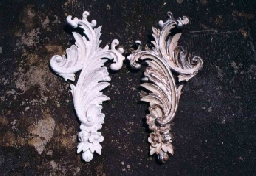 |
|
 |
|
|
fig.8.
click on to zoom |
|
fig.9.
click on to zoom |
|
|
|
| Mounting
New elements
for mounting of the crown were made of Pinewood (Pinus
nigra) and placed on the mirror frame. They were supported
with 10x5mm dowels and adhered with aliphatic resin
glue (4). To provide possibility of easy dismounting
crown was mounted by 4x5mm screws. Also, peace's of
leader was placed in order to provide better connection
and higher friction between elements (fig.13.).
Original 10 mm thick mirror glass was placed and held
by dowels.
|
|
|
|
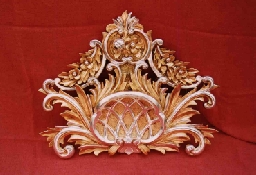 |
|
|
|
|
|
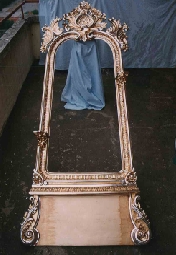 |
|
|
fig.10.
click on to zoom |
|
|
|
|
|
|
|
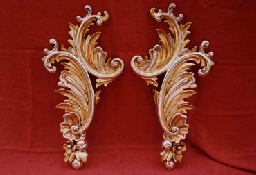 |
|
|
|
fig.11.
click on to zoom |
|
|
|
|
|
|
|
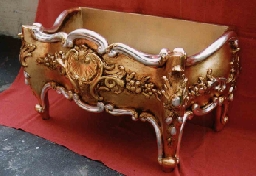 |
|
|
|
|
fig.13.
click on to zoom |
|
|
|
|
|
|
fig.12.
click on to zoom |
|
|
|
|
|
| List
Of Used Prefabricated Materials
1. Acid
paint remover: Karuwa - Brutal Abbeizer , Feidal GmbH,
Germany
2. Nitro thinner: HB Body , Grece
3. CLOU filing wax: Clou wax, Germany
4. Aliphatic resin glue: Titebond wood glue , Franklin
International , USA
5. Model plaster: Krone Hiliges Gipswerk, Germany
6. Bole: Red, Lefranc & Bourgeois France
7. Nitro ground: Duga, Yugoslavia
8. Synthetic oil size: Goldanlegeol - Mixtion, Lukas,
Germany
9. Dark red neutral pigment: Lefranc & Bourgeois
France
10. Bitumen from judeja: Liberon , France
11. Zapon lacquer: Liberon , France
12. Waterproof gold effect spray paint: Hadrien spray
paint, Costo Paints LTD., Grece
Applied
Gold, Silver and Metal Leafs
Gold leafs:
Orange Doppel Gold, 22 Karat, Noris, Germany
Silver leafs: Blattssilber Normal, Noris, Germany
Dutch metal: Noris, Germany
|
|
|
|
|
|
|